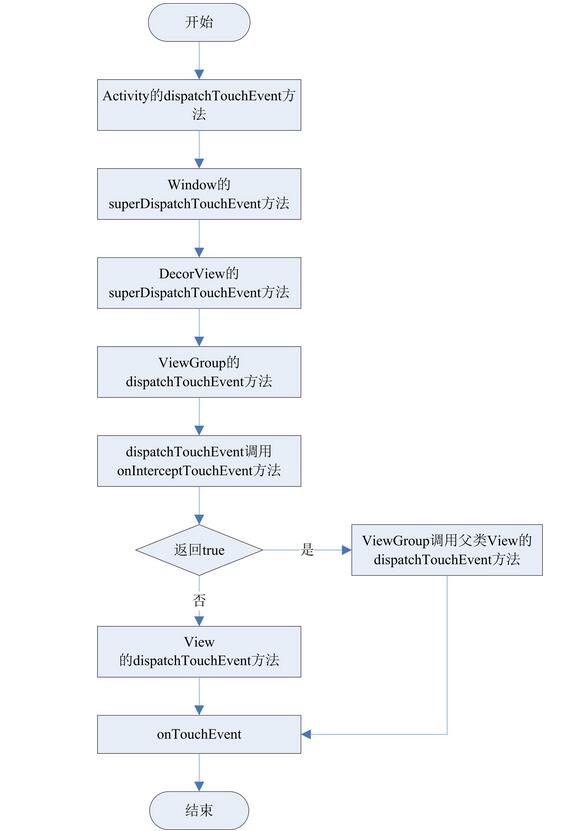综述
Android中的事件分发机制也就是View与ViewGroup的对事件的分发与处理。在ViewGroup的内部包含了许多View,而ViewGroup继承自View,所以ViewGroup本身也是一个View。对于事件可以通过ViewGroup下发到它的子View并交由子View进行处理,而ViewGroup本身也能够对事件做出处理。下面就来详细分析一下ViewGroup对时间的分发处理。
MotionEvent
当手指接触到屏幕以后,所产生的一系列的事件中,都是由以下三种事件类型组成。
1. ACTION_DOWN: 手指按下屏幕
2. ACTION_MOVE: 手指在屏幕上移动
3. ACTION_UP: 手指从屏幕上抬起
例如一个简单的屏幕触摸动作触发了一系列Touch事件:ACTION_DOWN->ACTION_MOVE->…->ACTION_MOVE->ACTION_UP
对于Android中的这个事件分发机制,其中的这个事件指的就是MotionEvent。而View的对事件的分发也是对MotionEvent的分发操作。可以通过getRawX和getRawY来获取事件相对于屏幕左上角的横纵坐标。通过getX()和getY()来获取事件相对于当前View左上角的横纵坐标。
三个重要方法
public boolean dispatchTouchEvent(MotionEvent ev)
这是一个对事件分发的方法。如果一个事件传递给了当前的View,那么当前View一定会调用该方法。对于dispatchTouchEvent的返回类型是boolean类型的,返回结果表示是否消耗了这个事件,如果返回的是true,就表明了这个View已经被消耗,不会再继续向下传递。
public boolean onInterceptTouchEvent(MotionEvent ev)
该方法存在于ViewGroup类中,对于View类并无此方法。表示是否拦截某个事件,ViewGroup如果成功拦截某个事件,那么这个事件就不在向下进行传递。对于同一个事件序列当中,当前View若是成功拦截该事件,那么对于后面的一系列事件不会再次调用该方法。返回的结果表示是否拦截当前事件,默认返回false。由于一个View它已经处于最底层,它不会存在子控件,所以无该方法。
public boolean onTouchEvent(MotionEvent event)
这个方法被dispatchTouchEvent调用,用来处理事件,对于返回的结果用来表示是否消耗掉当前事件。如果不消耗当前事件的话,那么对于在同一个事件序列当中,当前View就不会再次接收到事件。
View事件分发流程图
对于事件的分发,在这里先通过一个流程图来看一下整个分发过程。
ViewGroup事件分发源码分析
根据上面的流程图现在就详细的来分析一下ViewGroup事件分发的整个过程。
手指在触摸屏上滑动所产生的一系列事件,当Activity接收到这些事件通过调用Activity的dispatchTouchEvent方法来进行对事件的分发操作。下面就来看一下Activity的dispatchTouchEvent方法。
public boolean dispatchTouchEvent(MotionEvent ev) {
if (ev.getAction() == MotionEvent.ACTION_DOWN) {
onUserInteraction();
}
if (getWindow().superDispatchTouchEvent(ev)) {
return true;
}
return onTouchEvent(ev);
}
通过getWindow().superDispatchTouchEvent(ev)这个方法可以看出来,这个时候Activity又会将事件交由Window处理。Window它是一个抽象类,它的具体实现只有一个PhoneWindow,也就是说这个时候,Activity将事件交由PhoneWindow中的superDispatchTouchEvent方法。现在跟踪进去看一下这个superDispatchTouchEvent代码。
public boolean superDispatchTouchEvent(MotionEvent event) {
return mDecor.superDispatchTouchEvent(event);
}
这里面的mDecor它是一个DecorView,DecorView它是一个Activity的顶级View。它是PhoneWindow的一个内部类,继承自FrameLayout。于是在这个时候事件又交由DecorView的superDispatchTouchEvent方法来处理。下面就来看一下这个superDispatchTouchEvent方法。
public boolean superDispatchTouchEvent(MotionEvent event) {
return super.dispatchTouchEvent(event);
}
在这个时候就能够很清晰的看到DecorView它调用了父类的dispatchTouchEvent方法。在上面说到DecorView它继承了FrameLayout,而这个FrameLayout又继承自ViewGroup。所以在这个时候事件就开始交给了ViewGroup进行处理了。下面就开始详细看下这个ViewGroup的dispatchTouchEvent方法。由于dispatchTouchEvent代码比较长,在这里就摘取部分代码进行说明。
// Handle an initial down.
if (actionMasked == MotionEvent.ACTION_DOWN) {
// Throw away all previous state when starting a new touch gesture.
// The framework may have dropped the up or cancel event for the previous gesture
// due to an app switch, ANR, or some other state change.
cancelAndClearTouchTargets(ev);
resetTouchState();
}
从上面代码可以看出,在dispatchTouchEvent中,会对接收的事件进行判断,当接收到的是ACTION_DOWN事件时,便会清空事件分发的目标和状态。然后执行resetTouchState方法重置了触摸状态。下面就来看一下这两个方法。
1. cancelAndClearTouchTargets(ev)
private TouchTarget mFirstTouchTarget;
......
private void cancelAndClearTouchTargets(MotionEvent event) {
if (mFirstTouchTarget != null) {
boolean syntheticEvent = false;
if (event == null) {
final long now = SystemClock.uptimeMillis();
event = MotionEvent.obtain(now, now,
MotionEvent.ACTION_CANCEL, 0.0f, 0.0f, 0);
event.setSource(InputDevice.SOURCE_TOUCHSCREEN);
syntheticEvent = true;
}
for (TouchTarget target = mFirstTouchTarget; target != null; target = target.next) {
resetCancelNextUpFlag(target.child);
dispatchTransformedTouchEvent(event, true, target.child, target.pointerIdBits);
}
clearTouchTargets();
if (syntheticEvent) {
event.recycle();
}
}
}
在这里先介绍一下mFirstTouchTarget,它是TouchTarget对象,TouchTarget是ViewGroup的一个内部类,TouchTarget采用链表数据结构进行存储View。而在这个方法中主要的作用就是清空mFirstTouchTarget链表并将mFirstTouchTarget设为空。
2. resetTouchState()
private void resetTouchState() {
clearTouchTargets();
resetCancelNextUpFlag(this);
mGroupFlags &= ~FLAG_DISALLOW_INTERCEPT;
mNestedScrollAxes = SCROLL_AXIS_NONE;
}
在这里介绍一下FLAG_DISALLOW_INTERCEPT标记,这是禁止ViewGroup拦截事件的标记,可以通过requestDisallowInterceptTouchEvent方法来设置这个标记,当设置了这个标记以后,ViewGroup便无法拦截除了ACTION_DOWN以外的其它事件。因为在上面代码中可以看出,当事件为ACTION_DOWN时,会重置FLAG_DISALLOW_INTERCEPT标记。
那么下面就再次回到dispatchTouchEvent方法中继续看它的源代码。
// Check for interception.
final boolean intercepted;
if (actionMasked == MotionEvent.ACTION_DOWN
|| mFirstTouchTarget != null) {
final boolean disallowIntercept = (mGroupFlags & FLAG_DISALLOW_INTERCEPT) != 0;
if (!disallowIntercept) {
intercepted = onInterceptTouchEvent(ev);
ev.setAction(action); // restore action in case it was changed
} else {
intercepted = false;
}
} else {
// There are no touch targets and this action is not an initial down
// so this view group continues to intercept touches.
intercepted = true;
}
这段代码主要就是ViewGroup对事件是否需要拦截进行的判断。下面先对mFirstTouchTarget是否为null这两种情况进行说明。当事件没有被拦截时,ViewGroup的子元素成功处理事件后,mFirstTouchTarget会被赋值并且指向其子元素。也就是说这个时候mFirstTouchTarget!=null。可是一旦事件被拦截,mFirstTouchTarget不会被赋值,mFirstTouchTarget也就为null。
在上面代码中可以看到根据actionMasked==MotionEvent.ACTION_DOWN||mFirstTouchTarget!=null这两个情况进行判断事件是否需要拦截。对于actionMasked==MotionEvent.ACTION_DOWN这个条件很好理解,对于mFirstTouchTarget!=null的两种情况上面已经说明。那么对于一个事件序列,当事件为MotionEvent.ACTION_DOWN时,会重置FLAG_DISALLOW_INTERCEPT,也就是说!disallowIntercept一定为true,必然会执行onInterceptTouchEvent方法,对于onInterceptTouchEvent方法默认返回为false,所以需要ViewGroup拦截事件时,必须重写onInterceptTouchEvent方法,并返回true。这里有一点需要注意,对于一个事件序列,一旦序列中的某一个事件被成功拦截,执行了onInterceptTouchEvent方法,也就是说onInterceptTouchEvent返回值为true,那么该事件之后一系列事件对于条件actionMasked==MotionEvent.ACTION_DOWN||mFirstTouchTarget!=null必然为false,那么这个时候该事件序列剩下的一系列事件将会被拦截,并且不会执行onInterceptTouchEvent方法。于是在这里得出一个结论:对于一个事件序列,当其中某一个事件成功拦截时,那么对于剩下的一系列事件也会被拦截,并且不会再次执行onInterceptTouchEvent方法
下面再来看一下对于ViewGroup并没有拦截事件是如何进行处理的。
final int childrenCount = mChildrenCount;
if (newTouchTarget == null && childrenCount != 0) {
final float x = ev.getX(actionIndex);
final float y = ev.getY(actionIndex);
// Find a child that can receive the event.
// Scan children from front to back.
final ArrayList preorderedList = buildOrderedChildList();
final boolean customOrder = preorderedList == null
&& isChildrenDrawingOrderEnabled();
final View[] children = mChildren;
for (int i = childrenCount - 1; i >= 0; i--) {
final int childIndex = customOrder
? getChildDrawingOrder(childrenCount, i) : i;
final View child = (preorderedList == null)
? children[childIndex] : preorderedList.get(childIndex);
// If there is a view that has accessibility focus we want it
// to get the event first and if not handled we will perform a
// normal dispatch. We may do a double iteration but this is
// safer given the timeframe.
if (childWithAccessibilityFocus != null) {
if (childWithAccessibilityFocus != child) {
continue;
}
childWithAccessibilityFocus = null;
i = childrenCount - 1;
}
if (!canViewReceivePointerEvents(child)
|| !isTransformedTouchPointInView(x, y, child, null)) {
ev.setTargetAccessibilityFocus(false);
continue;
}
newTouchTarget = getTouchTarget(child);
if (newTouchTarget != null) {
// Child is already receiving touch within its bounds.
// Give it the new pointer in addition to the ones it is handling.
newTouchTarget.pointerIdBits |= idBitsToAssign;
break;
}
resetCancelNextUpFlag(child);
if (dispatchTransformedTouchEvent(ev, false, child, idBitsToAssign)) {
// Child wants to receive touch within its bounds.
mLastTouchDownTime = ev.getDownTime();
if (preorderedList != null) {
// childIndex points into presorted list, find original index
for (int j = 0; j < childrenCount; j++) {
if (children[childIndex] == mChildren[j]) {
mLastTouchDownIndex = j;
break;
}
}
} else {
mLastTouchDownIndex = childIndex;
}
mLastTouchDownX = ev.getX();
mLastTouchDownY = ev.getY();
newTouchTarget = addTouchTarget(child, idBitsToAssign);
alreadyDispatchedToNewTouchTarget = true;
break;
}
// The accessibility focus didn't handle the event, so clear
// the flag and do a normal dispatch to all children.
ev.setTargetAccessibilityFocus(false);
}
if (preorderedList != null) preorderedList.clear();
}
对于这段代码虽然说比较长,但是在这里面的逻辑去不是很复杂。首先获取当前ViewGroup中的子View和ViewGroup的数量。然后对该ViewGroup中的元素进行逐步遍历。在获取到ViewGroup中的子元素后,判断该元素是否能够接收触摸事件。子元素若是能够接收触摸事件,并且该触摸坐标在子元素的可视范围内的话,便继续向下执行。否则就continue。对于衡量子元素能否接收到触摸事件的标准有两个:子元素是否在播放动画和点击事件的坐标是否在子元素的区域内。
一旦子View接收到了触摸事件,然后便开始调用dispatchTransformedTouchEvent方法对事件进行分发处理。对于dispatchTransformedTouchEvent方法代码比较多,现在只关注下面这五行代码。从下面5行代码中可以看出,这时候会调用子View的dispatchTouchEvent,也就是在这个时候ViewGroup已经完成了事件分发的整个过程。
if (child == null) {
handled = super.dispatchTouchEvent(event);
} else {
handled = child.dispatchTouchEvent(event);
}
当子元素的dispatchTouchEvent返回为true的时候,也就是子View对事件处理成功。这时候便会通过addTouchTarget方法对mFirstTouchTarget进行赋值。
如果dispatchTouchEvent返回了false,或者说当前的ViewGroup没有子元素的话,那么这个时候便会调用如下代码。
if (mFirstTouchTarget == null) {
// No touch targets so treat this as an ordinary view.
handled = dispatchTransformedTouchEvent(ev, canceled, null,
TouchTarget.ALL_POINTER_IDS);
}
在这里调用dispatchTransformedTouchEvent方法,并将child参数设为null。也就是执行了super.dispatchTouchEvent(event)方法。由于ViewGroup继承自View,所以这个时候又将事件交由父类的dispatchTouchEvent进行处理。对于父类View是如何通过dispatchTouchEvent对事件进行处理的,在下篇文章中会进行详细说明。
到这里对于ViewGroup的事件分发已经讲完了,在这一路下来,不难发现对于dispatchTouchEvent有一个boolean类型返回值。对于这个返回值,当返回true的时候表示当前事件处理成功,若是返回false,一般来说是因为在事件处理onTouchEvent返回了false,这时候变会交由它的父控件进行处理,以此类推,若是一直处理失败,则最终会交由Activity的onTouchEvent方法进行处理。
总结
在这里从宏观上再看一下这个ViewGroup对事件的分发,当ViewGroup接收一个事件序列以后,首先会判断是否拦截该事件,若是拦截该事件,则通过调用父类View的dispatchTouchEvent来处理这个事件。若是不去拦截这一事件,便将该事件下发到子View当中。若果说ViewGroup没有子View,或者说子View对事件处理失败,则将该事件有交由该ViewGroup处理,若是该ViewGroup对事件依然处理失败,最终则会将事件交由Activity进行处理。
以上就是本文的全部内容,希望对大家的学习有所帮助,也希望大家多多支持脚本之家。
